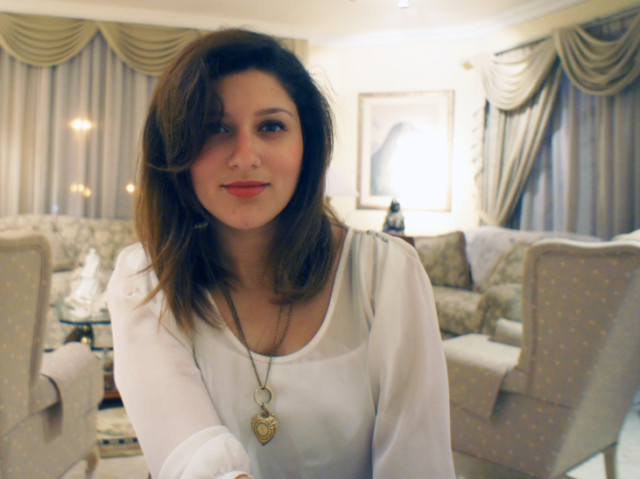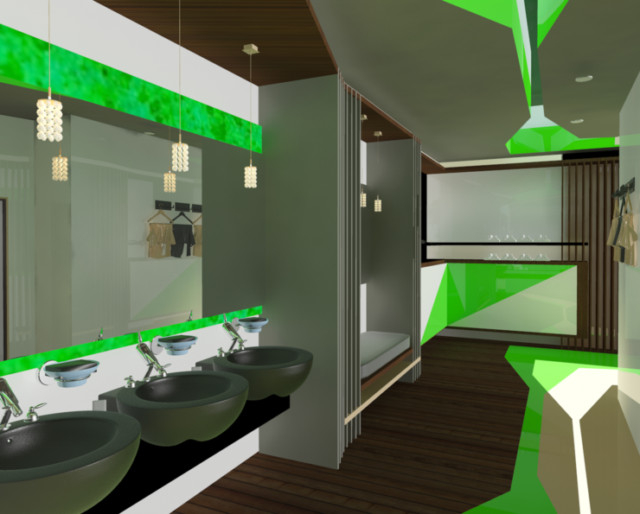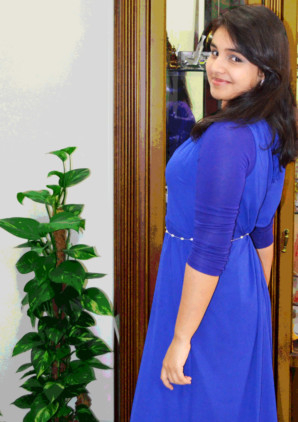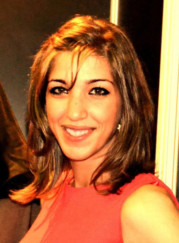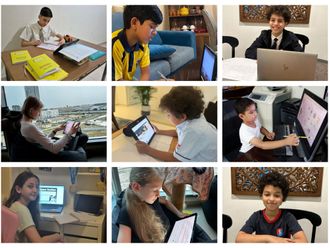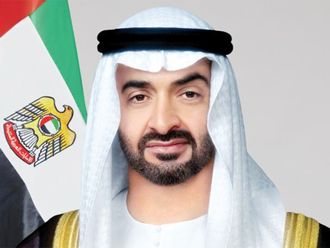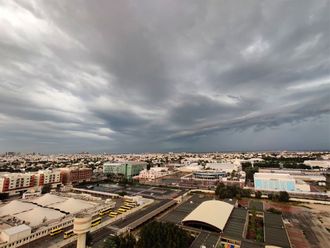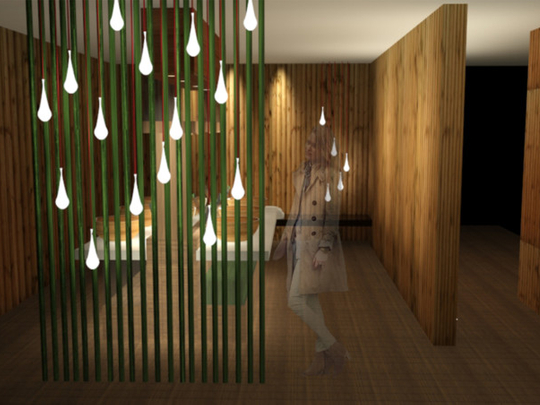
Delta Faucet Company Middle East, a worldwide leader in commercial and residential faucets, held a contest among students of the American University of Dubai (AUD) to come up with sustainable bathroom designs.
Of the 23 students who participated three – Anne Wagdi El Meri, Mahy Hussein and Erum Kamal – were declared winners in the first, second and third place respectively. They provided aesthetically planned, yet innovative and sustainable bathroom designs with several conservation features.
There is much more to bathroom and faucet designs than just gleaming looks and pretty contours. In today’s eco-conservative times, while form takes its pride of place, function is equally important. So the question put to the students of the American University of Dubai for the contest in sustainable bathrooms was: ‘Is your bathroom designed for optimal sustainability?’
This was one of the most important idea behind the launching of a contest by Delta Faucet Company, a worldwide leader in residential and commercial faucets.
Early this year, it invited 23 students from the American University of Dubai to participate in “The Sustainable Bathrooms in the UAE” contest. The three spoke to Education about the rationale behind their winning designs.
Anne Wagdi El Meri
Age: 21
Nationality:
Egyptian/Canadian
Programme: Pursuing a Major in Interior Design from AUD.
What inspired your faucet design?
I was inspired by this trend of using plants in order to create a more green environment, such as replacing wood with bamboo. After extensive research, I realised that if we all start using bamboo more often, we will definitely prevent deforestation which is a huge global dilemma.
Modern technology can be harnessed in different ways, for example, using plants to clean the air by removing toxins using the Bel Air Technology and cleaning and reusing water by removing wastage completely by using reeds from the “Reed Bed System”. If we encourage the use of these technologies, we will prevent global warming as already, we are seeing some changes in the world especially in our oceans. This change of approach will create a healthy sustainable world for the future generations.
Green Technology is also a huge inspiration to my project. Unfortunately, we don’t take advantage of the gift of technology by using it to save our environment and therefore, as future designers, we should all begin to do so.
There are always ways to be cost-effective and sustainable at the same time. Materials such bamboo as an alternative to wood definitely requires a lot less maintenance. Therefore, not only will the use of bamboo allows us to be more sustainable, we’ll also be a lot lighter with our savings.
How close is the concept of sustainability to your heart?
The concept of being sustainable plays a big role in my life. Throughout my school and university years, the majority of my education has been focused on being aware with how we in our daily lives negatively affect our environment.
Do you practice sustainability in your everyday life?
I do recycle as much as possible. For example, finding ways to reuse plastics since they are not bio-degradable, replacing chemical products with green products which includes hair and skin products and saving water as much as possible.
Will winning this award help your career?
This has been an eye-opening experience for me. The biggest advantage about winning this project is not only that I have learnt a lot from it, but I could to share it with the community, educate people that we can be green and environmentally friendly without destroying our wallets as well as create varieties in our designs. I believe winning this award will open new doors for me and creating a more direct path for my career.
What are your plans?
My ambition in life is to combine modern interactive technology with interior design. I would like people to not only see, but to touch, feel, smell and fully experience and interact with my designs. My plans are to study masters degrees in stage design and interactive design - I would like to learn more about interactive technology, and create or invent my own in order to solve design problems in the future.
I have always wanted to get the Leeds certificate, but due to my responsibilities in my university, I was not able to find the time. Now that I have graduated, and am about to enter my career, I definitely have a chance to study and apply for the Leeds certificates and join the Green Leeds community in helping the environment through architecture and design.
Erum Kamal
Age: 22
Nationality: Pakistani
Degree: Bachelor in Fine Arts (Interior Design) with Integrated Computational Design Along with a Minor in Architecture
What inspired your faucet design?
The faucet design is meant to be extremely simple, made with recycled aluminum, to draw attention of the user towards the usage of water. The design is taken from nature - from the microscopic view of a leaf. The structure of the leaf and the nutrients it needs to grow was taken into consideration when designing. A plant usually takes in nutrients from its root and disperses it right up to the tip of the leaf. The way the plant works and distributes the nutrients within it became the inspiration and design idea behind the bathroom design.
A bathroom has to be sustainable. Sunlight or natural light, water that includes fresh water as well as grey water, and ventilation to allow for a healthy internal environment that prevents molds to grow, are all factors that were implemented in the design.
Other ideas used to enhance the idea of sustainability were through the materials used, like syndecrete (a material made from recycled glass) and eco-friendly epoxy to promote a long-lasting finish. My project, Sustainable Growth, is meant to make users psychologically aware of the idea of sustainability without taking away from the visual appeal of the design.
How much of attention was paid to conservation of water and to the symmetry of design?
In terms of conservation of water, a couple of factors were taken into consideration. To begin with, the sinks were equipped with a button that would drain the water in it only after it is manually pressed. This allows the user to be fully concious of the fact that the sink is filling up.
Furthermore, the water drained from the sink is collected to be directed towards the toilet tanks. The toilets tanks used are low flush, in that they are able to take in the water from the sinks drainage. Another way the water is conserved is to collect the water that is accidentally spilled on the floor. This water collected through the narrow gaps created in the wooden flooring directs it to be filtered before being used to water plants.
How close is the concept of sustainability to your heart?
Because of the influence sustainability has had on my knowledge, when I create a design, terms such as ventilation, natural light, and conservation automatically come to mind.
Do you practice sustainability in your everyday life?
Of course. Recycling paper, disposing them to get recycled, and not allowing the tap run while waiting for the water to get hot.
Is it possible to be cost-effective and sustainable at the same time?
Yes. As designers, we realise that sustainability doesn’t always have to mean spending money because it’s about how you perceive the idea. For example, using a flooring material that is not only strong and well-finished but also durable allows you to save costs in the long term. This could be for any type of flooring: wood, marble, or ceramic. They all require a process to get to the final product which is adds to the carbon footprint. So it is better to pay a little more to get a design that lasts.
How will this award help your career?
It will create importance for a place that is usually neglected in a residential or commercial plan. At the end of the day, this sustainable bathroom competition made us aware not only as designers but gave us an understanding of how to achieve a bathroom that is eco-friendly and good to look at.
What are your plans?
I plan to continue working as I am doing now (frelancing), and then having a full-time job. I would also like to consider doing a masters degree a couple of years from now.
Mahy Hussein
Age: 23
Degree: BFA Interior Design
Nationality: German
What inspired your faucet design?
Seeing that I designed a commercial lavatory facility in a reptile exhibition structure, my faucet was inspired by the curvilinear movement of a cobra. The cobra-inspired faucet also housed a removable filtration (inspired by the LifeStraw) unit that is intended as one of the filtration methods in the bathroom.
After the water is used by the visitors, the soap water would pass through the pipes all the way down to the lower level of the structure, only to go through a series of tropical plants, which also act as an attention-grabber to the visitor, and get filtered plant by plant.
These plants take their nutrients from the grey water and pass on the organically filtered water. The final stage is for the water to travel back up to the lavatory facility with the use of two pressurised collector tanks and eventually would travel through the faucet and the filtration unit (the Cobra Head).
How much of attention was paid to conservation of water and to the symmetry of design?
It was important to find a solution that would make use of the grey-water rather than disposing of it, where it would get chemically treated. Organic filtration allows the water to be recycled over and over again, whilst giving nourishment to the plants housing the structure. Aesthetically, plants were crucial in order to represent the theme of the exhibition structure.
How close is the concept of sustainability to your heart?
Sustainability to me became more of a mentality rather than a specific field of practice. I truly believe that the more people are aware of the impact we have, the more it becomes a norm to act within the framework of Eco-consciousness.
Do you practice sustainability in your everyday life?
I do the best I could do given the limited possibilities, unfortunately. Don’t leave electronics running unnecessarily, A/C is off when I’m not at home, I don’t keep the water running when brushing my teeth or doing the dishes.
Yet, I feel it makes more sense as a designer to keep developing concepts that would manage energy and water conservation on a bigger scale. In other words, architecturally, these aspects can be directly controlled and the impact becomes greater in collaboration with the awareness provided to end-users.
How will this award help your career?
This award has given me the pat on the back I needed to show me that I’m heading in the right direction. It has helped me shape an understanding of what I am capable of and that, I believe, is the perfect stepping stone into the career world.
What are your plans?
I currently work at Hospitality Design Partnership. There I intend to build myself up. In the future, I would like to get a Master’s Degree in Design & Sustainability. With that I hope to give my best in making contributions to eco-driven design.


